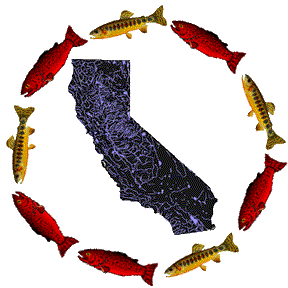CSPA |
| "Southern California is facing increasingly limited periods of time when water is accessible in Northern California and can be delivered to our region. So when water is available, we must be prepared to move large volumes of water during a relatively short time and then store it for use during dry periods and emergencies." Metropolitan board Chairman Timothy F. Brick |
| Your 501(c)(3) tax deductible cash donations are desperately needed if the fight for our fisheries is to continue. Read how you can donate! |

 More News
More News
![]()
Is this really GOOD news?
Nearly 4-Mile Tunnel is Last Piece of 44-Mile Metropolitan Water District Water Line That Will Send Even More Delta Water South
Metropolitan Water District, Bob Muir, 213-217-6930
DEVIL CANYON, Calif., Aug 20, 2008 (BUSINESS WIRE) -- A 450-foot tunnel-boring machine emerged from under the San Bernardino Mountains today, creating a nearly four-mile tunnel as part of a large-diameter regional water line that will help improve the quality and reliability of imported water serving nearly 19 million Southern Californians.
The breakthrough completes the massive mechanical mole's nearly five-year passage through dirt, rocks and granite up to 1,500 feet beneath the mountain range, as part of Metropolitan Water District's Inland Feeder project.
"For those of us who have followed this project since it first appeared on the drawing board 20 years ago, this is truly a thrilling moment," said Metropolitan board Chairman Timothy F. Brick. "This is a landmark achievement for the Inland Feeder, a vital link in securing a more reliable, higher-quality water supply for Southern Californians."
The 3.8-mile Arrowhead West Tunnel is the last of three needed for the 44-mile Inland Feeder, a high-capacity, gravity-fed water delivery system stretching from the foothills of the San Bernardino Mountains to Metropolitan's Colorado River Aqueduct in the Riverside County community of San Jacinto. Mining on the other two project tunnels--the 4.3-mile Arrowhead East Tunnel and 8-mile Badlands Tunnel--was completed last May and in July 2001, respectively.
When completed in 2010, the Inland Feeder will provide Metropolitan the flexibility to deliver water when available from Northern California during wet periods--primarily during the winter when it rains.
The feeder also will improve the quality of Southern California's water supply by allowing more uniform blending of water from Northern California with Colorado River supplies, which have a higher mineral content.
"Southern California is facing increasingly limited periods of time when water is accessible in Northern California and can be delivered to our region," Brick said. "So when water is available, we must be prepared to move large volumes of water during a relatively short time and then store it for use during dry periods and emergencies."
First envisioned in the late 1980s, the $1.2 billion Inland Feeder will deliver water to be stored in surface reservoirs, such as Metropolitan's Diamond Valley Lake near Hemet in southwest Riverside County, and groundwater basins for later use.
Metropolitan General Manager Jeff Kightlinger said the project will help Southern California cope with future weather pattern uncertainties, which may bring more rain and less snowpack to Northern California, and longer periods of drought to Southern California.
"History shows that changes in climate and weather are inevitable, bringing significant uncertainties in our climate and our water demands," Kightlinger said. "Projects like the Inland Feeder will help accommodate the inevitable changes in climate and weather that our region will experience. By understanding our climate past and carefully considering our climate future, we have made a thoughtful, prudent investment in our future."
Gene Koopman, chair of the Metropolitan board's Engineering and Capital Programs Committee and Inland Empire Utilities Agency representative on the MWD board, called the feeder "one of the most demanding construction projects" in the agency's 80-year history.
"Construction of the Arrowhead west and east tunnels was challenging, not only due to the physical constraints of mining in such extremely difficult geologic conditions and so close to several earthquake faults, but also because of other hazards unique to Southern California that were encountered--fires and flash floods," Koopman said.
Koopman noted that in October 2003, a 100,000-acre wildfire engulfed the Arrowhead West Tunnel portal in Waterman Canyon, destroying numerous pieces of construction equipment. Two months later on Dec. 25, a strong, sudden winter storm drenched the charred mountain area, releasing a torrent of mud, water and rock down the canyon and flooding the same portal site and tunnel-boring machine, as well as washing away equipment.